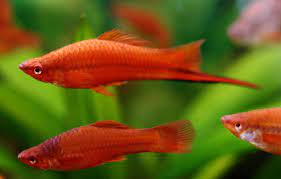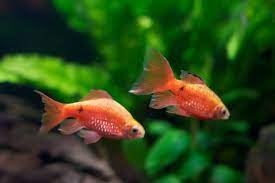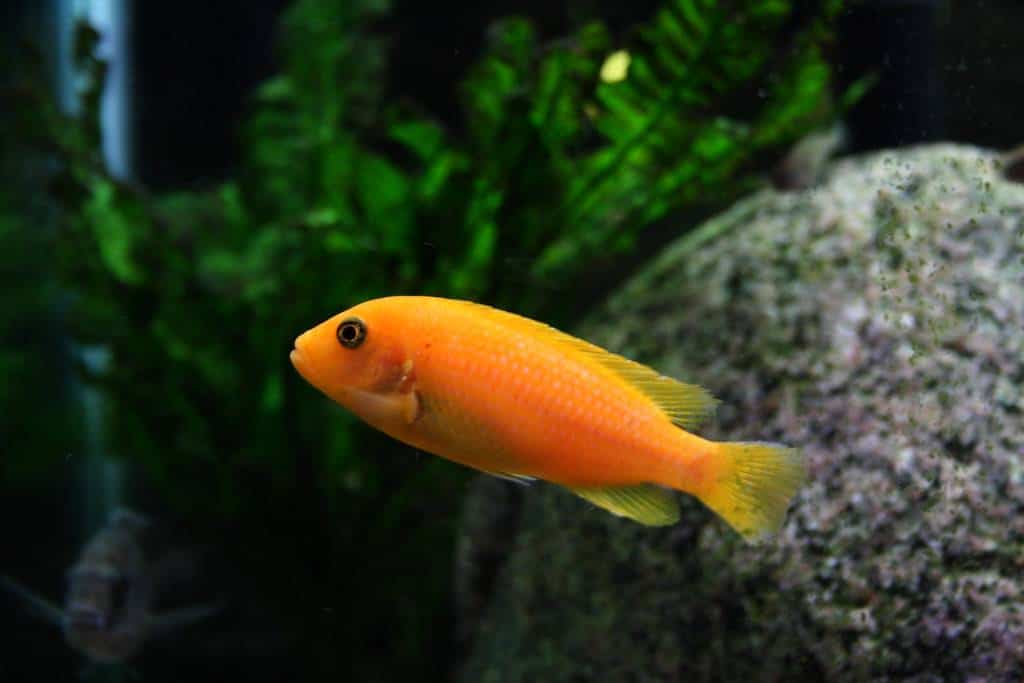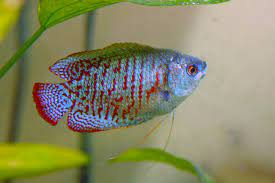Freshwater aquariums can provide hours of entertainment and relaxation as we watch the different species of fish swimming and interacting with each other. One of the most intriguing behaviors to observe is the schooling of fish. Schools of fish move in a coordinated and synchronized manner, making it a mesmerizing sight. In this article, we will explore the top 10 schooling freshwater aquarium fish, and delve into the fascinating world of fish schooling behavior. We will also answer some questions such as why do schools of fish swim in circles, how do they communicate, how they swim in harmony, the meaning of a school of fish, and the difference between school and shoal of fish. We will also discuss how many fish constitute a school of fish. This article will provide an in-depth understanding of fish schooling behavior and enhance the enjoyment of owning a freshwater aquarium.
Table of Contents
Neon Tetra

The neon tetra (Paracheirodon innesi) is a small, brightly colored fish that is a popular choice for freshwater aquariums. They are known for their electric blue and red colors and are often kept in schools of six or more. They are peaceful and easy to care for, making them a great choice for beginners. Neon tetras are native to the Orinoco and Amazon River basins in South America. They prefer water temperatures between 72-82°F and pH between 5.5-7.5. They are best kept in an aquarium with other peaceful fish and a well-planted environment. They are also known for their bioluminescent abilities, which can add an interesting dynamic to an aquarium.
Guppies

Guppies (Poecilia reticulata) are another popular choice for freshwater aquariums, and they are known for their bright colors and active behavior. They are also peaceful and easy to care for, and they tend to school in larger groups than neon tetras. Guppies are native to the Caribbean and parts of South America. They prefer water temperatures between 72-82°F and pH between 7.0-8.0. They are best kept in an aquarium with other peaceful fish and a well-planted environment. They are also known for their ability to reproduce quickly, making them an interesting addition to an aquarium.
Danios

Danios (Danio spp.) are a type of minnow that are known for their active and energetic behavior. They are often kept in schools of six or more and are a great choice for a lively and active aquarium. They are native to rivers and streams in India, Bangladesh and Myanmar. They prefer water temperatures between 64-75°F and pH between 6.0-7.5. They are best kept in an aquarium with other active fish and a well-planted environment.
Rasboras

Rasboras (Rasbora spp.) are a type of small fish that are known for their peaceful and timid behavior. They are often kept in schools of six or more and can add a peaceful and calming presence to an aquarium. They are native to Southeast Asia. They prefer water temperatures between 72-82°F and pH between 6.0-7.5. They are best kept in an aquarium with other peaceful fish and a well-planted environment.
Swordtails

Swordtails (Xiphophorus helleri) are a type of fish that are known for their striking appearance and active behavior. They are often kept in schools of six or more and can add a touch of drama to an aquarium. They are native to Mexico and Central America. They prefer water temperatures between 72-82°F and pH between 7.0-8.0. They are best kept in an aquarium with other active fish and a well-planted environment.
Barbs

Barbs (Barb spp.) are a type of fish that are known for their active and energetic behavior. They are often kept in schools of six or more and can add a lively and active presence to an aquarium. They are native to Southeast Asia. They prefer water temperatures between 72-82°F and pH between 6.0-7.5. They are best kept in an aquarium with other active fish and a well-planted environment.
Platies

Platies (Xiphophorus maculatus) are a type of fish that are known for their peaceful and easy-going behavior. They are often kept in schools of six or more and can add a peaceful and calming presence to an aquarium.They are native to Central America and Mexico. They prefer water temperatures between 72-82°F and pH between 7.0-8.0. They are best kept in an aquarium with other peaceful fish and a well-planted environment.
Mollies

Mollies (Poecilia spp.) are a type of fish that are known for their striking appearance and peaceful behavior. They are often kept in schools of six or more and can add a touch of elegance to an aquarium. They are native to Central America, Mexico and parts of South America. They prefer water temperatures between 72-82°F and pH between 7.0-8.0. They are best kept in an aquarium with other peaceful fish and a well-planted environment.
Cichlids

Cichlids (Cichlidae) are a type of fish that are known for their striking appearance and active behavior. They are often kept in schools of six or more and can add a touch of drama to an aquarium. They are native to many regions of the world, including Africa, Central America, and South America. They prefer water temperatures and pH that vary depending on the species. They are best kept in an aquarium with other active fish and a well-planted environment.
Gouramis

Gouramis (Osphronemidae) are a type of fish that are known for their peaceful and easy-going behavior. They are often kept in schools of six or more and can add a peaceful and calming presence to an aquarium. They are native to Southeast Asia and India. They prefer water temperatures between 72-82°F and pH between 6.0-7.5. They are best kept in an aquarium with other peaceful fish and a well-planted environment.
It’s important to note that when keeping these fish in an aquarium, it’s important to research their specific needs and requirements, including water parameters, tank size, and compatibility with other species, in order to ensure a healthy and happy environment for the fish.
In addition to the information provided above, it’s also important to consider the size and behavior of the fish when creating a school in an aquarium. Some species, such as cichlids, can be more aggressive and territorial, so it’s important to keep them with other fish that can hold their own and not get bullied.
It’s also important to provide enough space for the fish to swim and move comfortably, A general rule of thumb is to have at least 1 gallon of water per inch of fish.
Also, it’s important to note that not all species of fish enjoy schooling and some species may prefer to live alone or in smaller groups. It’s important to research the specific behavior and social needs of the fish you plan to keep in your aquarium, to ensure that they are happy and healthy.
Now that we have discussed the top 10 schooling freshwater aquarium fish, let’s dive into the fascinating world of fish schooling behavior.
Why do fish swim in circles?
One of the most interesting aspects of fish schooling behavior is the way in which fish swim in circles. This behavior is known as cyclical swimming and is thought to be a way for fish to protect themselves from predators. When fish swim in circles, it makes it more difficult for a predator to single out one fish to attack, as the entire school is constantly moving.
How do fish communicate with each other?
Another interesting aspect of fish schooling behavior is the way in which fish communicate with one another. Fish are known to use a variety of different methods to communicate, including visual cues, chemical cues, and auditory cues. For example, fish may use their fins to signal to other fish, or they may use pheromones to communicate with one another.
Fish also swim in harmony within a school, by constantly adjusting their positions and movements in relation to one another. This coordinated swimming allows for the school to move as one unit and makes it more difficult for predators to single out one fish. It also allows for the efficient use of energy, as the fish can swim in the slipstream of one another.
School Vs Shoal
The term “school” or “shoal” of fish refers to a group of fish that are swimming together. The terms are often used interchangeably, but they do have slightly different meanings. A “school” of fish typically refers to a group of fish that are the same species and are swimming together for protection or feeding purposes. A “shoal” of fish, on the other hand, typically refers to a group of fish that are of different species and are swimming together for protection or feeding purposes.


How many fish are there in a school and shoal?
The exact number of fish in a school or shoal can vary depending on the species and the environment. However, it is generally accepted that a school of fish typically consists of at least six individuals.
Conclusion:
In conclusion, schools of fish are a fascinating and captivating aspect of freshwater aquariums. The top 10 schooling freshwater aquarium fish discussed in this article are all great choices for an aquarium, and they offer a glimpse into the fascinating world of fish schooling behavior. Understanding the behavior of fish schools can enhance the enjoyment of owning an aquarium.
It is also important to note that the terms “school” and “shoal” of fish are often used interchangeably but have slightly different meanings, and the number of fish in a school can vary depending on the species and the environment.
FAQs
Why do schools of fish swim in circles?
This behavior is known as cyclical swimming and is thought to be a way for fish to protect themselves from predators. When fish swim in circles, it makes it more difficult for a predator to single out one fish to attack, as the entire school is constantly moving.
What is a group of fish called?
A group of fish is called a school.
How do schools of fish communicate?
Fish are known to use a variety of different methods to communicate, including visual cues, chemical cues, and auditory cues. For example, fish may use their fins to signal to other fish, or they may use pheromones to communicate with one another.
How do schools of fish swim in harmony?
Fish swim in harmony by constantly adjusting their positions and movements in relation to one another. This coordinated swimming allows for the school to move as one unit and makes it more difficult for predators to single out one fish. It also allows for the efficient use of energy, as the fish can swim in the slipstream of one another.
What is the meaning of a school of fish?
The term “school” of fish refers to a group of fish that are swimming together for protection or feeding purposes.
Is it school or shoal of fish?
The terms “school” and “shoal” of fish are often used interchangeably but have slightly different meanings. A “school” of fish typically refers to a group of fish that are the same species and are swimming together for protection or feeding purposes. A “shoal” of fish, on the other hand, typically refers to a group of fish that are of different species and are swimming together for protection or feeding purposes.
How many is a school of fish?
The exact number of fish in a school can vary depending on the species and the environment. However, it is generally accepted that a school of fish typically consists of at least six individuals.
What is the difference between a school of fish and a shoal of fish?
A “school” of fish typically refers to a group of fish that are the same species and are swimming together for protection or feeding purposes. A “shoal” of fish, on the other hand, typically refers to a group of fish that are of different species and are swimming together for protection or feeding purposes.
Is it better to keep one species or multiple species in a school of fish?
It depends on the species of fish and their behavior. Some species may prefer to live alone or in smaller groups, while others may enjoy schooling. It’s important to research the specific behavior and social needs of the fish you plan to keep in your aquarium, to ensure that they are happy and healthy.
How can I create a healthy and happy environment for my school of fish?
By providing the right water parameters, tank size, and compatibility with other species, and ensuring that the fish have enough space to swim and move comfortably, you can create a healthy and happy environment for your school of fish. It’s also important to research the specific behavior and social needs of the fish you plan to keep in your aquarium, to ensure that they are happy and healthy.
If you are interested in this article you may also be interested in The 10 best community fish for a peaceful tank
If you need any help you can reach out to contact@praveen_inoutlook-com
Thanks.
I am a passionate aquarist with over 30 years of hands-on experience in fishkeeping. My journey began at a young age, collecting fish from the wild and learning through experimentation. Specializing in tropical fish, I bring a deep understanding of the hobby to FishKeepingMadeSimple. The site provides honest, detailed reviews of essential products and accessories to help fellow enthusiasts create the best environments for their fish.










[…] essential accessories and decorations to your betta fish tank can help create a healthy and visually pleasing environment for your beloved fish. Remember, […]
[…] Plecos, are a type of pleco with a dark black body adorned with white or yellowish spots. These stunning freshwater fish prefer fast-moving rivers in Brazil and have a calm temperament towards other species, although […]
[…] Tetras, also known as Gold Tetras, are small freshwater fish native to South America. They have a peaceful temperament and can live up to 3-4 years. These […]
[…] blue zebra fish, also known as the zebra danio, is a stunning freshwater fish species with vibrant blue and gold […]
[…] their natural hunting behaviors observed in the wild. While providing live feeder fish, such as guppies or small goldfish, ensures engagement and exercise, it is critical to be cautious about potential […]
[…] Both male and female Pristella Tetras display vibrant yellow, black, and red markings, making them a visually stunning addition to any tank. […]
[…] to the overall cleanliness of the aquarium. Consider adding a common molly to your 40-gallon tank for a visually stunning and lively aquatic […]